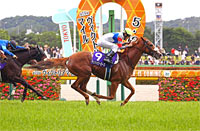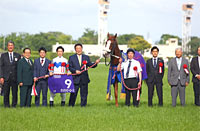Victoria Mile (G1) - Data Analysis
Spring queen decider for older filies and mares
The Victoria Mile is a 1,600 meters G1 race for older fillies and mares that was established in 2006. Race favorites have suffered six consecutive defeats in the race since 2014, resulting in a string of upset victories. The 2015 race stood out in particular with a Trifecta payout of JPY20 million. However, the last two races were won by the race favorites, so the question is whether this trend will continue this year, or whether a poorly favored runner will score a surprise victory. Let’s now look for some trends in this race based on the data for the last 10 years.
Runners with win odds in the 10.0-19.9 range look appealing from a betting standpoint
Looking at performances by runners over the last 10 years in terms of win odds, we find that runners with win odds in the 10.0-19.9 range delivered solid performance. Runners in this group even secured four consecutive victories: Straight Girl in 2015 (win odds of 14.1), Straight Girl in 2016 (17.7), Admire Lead in 2017 (13.5), and Jour Polaire in 2018 (19.4). As runners with win odds in the 10.0-19.9 range only failed to enter the Top 3 once in the last 10 years, we should regard them as leading contenders. [Table 1]
[Table 1] Performance by win odds (last 10 years)
| Win odds |
Performance
[1st-2nd-3rd-4th or lower] |
Win ratio |
Top 2 ratio |
Top 3 ratio |
| 9.9 or lower |
5-4-2-27 |
13.2% |
23.7% |
28.9% |
| 10.0-19.9 |
4-2-6-19 |
12.9% |
19.4% |
38.7% |
| 20 or higher |
1-4-2-101 |
0.9% |
4.6% |
6.5% |
Runners that suffered a major defeat in their previous race can still rise to the top
Over the last 10 years, runners that had triumphed in their previous race delivered lackluster performance. In fact, this group of 40 runners produced not a single winner. Since the highly favored runners were often unable to live up to expectations (examples include Smart Layer in 2014 [1st favorite, 8th place], Nuovo Record in 2015 [1st favorite, 6th place], and Mikki Queen in 2017 [1st favorite, 7th place]), we should be wary of runners that have secured the victory in their previous race. Put differently, runners that have not performed well in their previous race can still rise to the top. From 2013 to 2016, the race was won for four consecutive years by runners that had been beaten to 6th or lower in their previous race. [Table 2]
[Table 2] Performance by finish in previous race (last 10 years)
| Finish in previous race |
Performance
[1st-2nd-3rd-4th or lower] |
Win ratio |
Top 2 ratio |
Top 3 ratio |
| 1st |
0-3-0-37 |
0% |
7.5% |
7.5% |
| 2nd-5th |
4-4-9-38 |
7.3% |
14.5% |
30.9% |
| 6th or lower |
6-3-1-72 |
7.3% |
11.0% |
12.2% |
High success ratios for runners coming from the Nakayama Himba Stakes
All Top 3 finishers over the last 10 years came from one of the eight races shown in the table below. Among the main lead-up races, runners coming from the Hanshin Himba Stakes delivered the largest number of Top 3 finishers, runners coming from the Nakayama Himba Stakes achieved the highest success ratios, and runners coming from the Fukushima Himba Stakes produced zero winners. Furthermore, runners coming from the Osaka Hai, while fewer in number, have a high probability of finishing in the Top 3. If any of this year’s runners are coming from the Osaka Hai, we should focus on them. [Table 3]
[Table 3] Performance by major previous races (last 10 years)
| Previous race |
Performance
[1st-2nd-3rd-4th or lower] |
Win ratio |
Top 2 ratio |
Top 3 ratio |
| Hanshin Himba Stakes |
4-4-5-60 |
5.5% |
11.0% |
17.8% |
| Nakayama Himba Stakes |
2-2-0-8 |
16.7% |
33.3% |
33.3% |
| Osaka Hai |
2-1-1-1 |
40.0% |
60.0% |
80.0% |
| Takamatsunomiya Kinen |
1-0-2-16 |
5.3% |
5.3% |
15.8% |
Arima Kinen
(The Grand Prix) |
1-0-0-0 |
100% |
100% |
100% |
| Fukushima Himba Stakes |
0-1-2-22 |
0% |
4.0% |
12.0% |
| Lord Derby Challenge Trophy |
0-1-0-6 |
0% |
14.3% |
14.3% |
| Kyoto Himba Stakes |
0-1-0-4 |
0% |
20.0% |
20.0% |
Note: Only races that have produced Top 3 finishers are listed.
Note: Osaka Hai data includes data for 2016 and previous years, when the race was held as a G2 race.
Runners coming in with a lower carrying weight look appealing
Looking at performances by runners over the last 10 years in terms of changes in carrying weight, we find that runners coming in with a lower carrying weight than in their previous race achieved a high Top 3 ratio of 42.9%. In 2016, runners in this group occupied the entire Top 3 (Straight Girl 1st, Mikki Queen 2nd, and Shonan Pandora 3rd; carrying weight was down from 56kg to 55kg for each runner). In other words, if any runners come in with a lower carrying weight than in their previous race, we should pick them. [Table 4]
[Table 4] Performance by changes in carrying weight from previous race (last 10 years)
| Carrying weight |
Performance
[1st-2nd-3rd-4th or lower] |
Win ratio |
Top 2 ratio |
Top 3 ratio |
Lower carrying weight than in
previous race |
3-3-3-12 |
14.3% |
28.6% |
42.9% |
Same carrying weight as in
previous race |
4-3-2-48 |
7.0% |
12.3% |
15.8% |
Higher carrying weight than in
previous race |
3-4-5-87 |
3.0% |
7.1% |
12.1% |
Runners with shorter careers have fared well in recent years
The last five winners all had 15 or fewer career starts. Runners in this group also occupied the entire Top 3 in 2021, so runners with fewer career starts tend to perform well in this race. [Table 5]
[Table 5] Performance by total career starts (last five years)
| Total career starts |
Performance
[1st-2nd-3rd-4th or lower] |
Win ratio |
Top 2 ratio |
Top 3 ratio |
| 15 or fewer |
5-4-3-41 |
9.4% |
17.0% |
22.6% |
| 16 or more |
0-1-2-31 |
0% |
2.9% |
8.8% |
Seek out the winner!
Runners that performed well in a mile G1 race in the previous year and were highly favored in their previous race have the edge
Among the last 10 winners, nine had experience of finishing in the Top 5 of a 1,600m G1 race in the previous year. In particular, we should closely watch runners that have finished in the Top 5 of the Victoria Mile, the Oka Sho (Japanese 1000 Guineas), or the Yasuda Kinen in the previous year. In addition, the last 10 winners had all been backed as 5th favorite or higher in their previous race. This suggests we should also check the favoritism of runners in their previous race. [Table 6]
[Table 6] Winners’ major achievement in 1,600m G1 race in previous year, and favoritism in previous race (last 10 years)
| Year |
Winner |
Major achievement in 1,600m G1 race in
previous year |
Favoritism in previous race |
| 2012 |
Whale Capture |
Oka Sho (Japanese 1000 Guineas), 2nd |
2nd favorite |
| 2013 |
Verxina |
Oka Sho (Japanese 1000 Guineas), 2nd |
4th favorite |
| 2014 |
Verxina |
Victoria Mile, 1st |
5th favorite |
| 2015 |
Straight Girl |
Victoria Mile, 3rd |
1st favorite |
| 2016 |
Straight Girl |
Victoria Mile, 1st |
3rd favorite |
| 2017 |
Admire Lead |
Oka Sho (Japanese 1000 Guineas), 5th |
3rd favorite |
| 2018 |
Jour Polaire |
Victoria Mile, 3rd |
5th favorite |
| 2019 |
Normcore |
No applicable race entered |
1st favorite |
| 2020 |
Almond Eye |
Yasuda Kinen, 3rd |
1st favorite |
| 2021 |
Gran Alegria |
Yasuda Kinen, 1st, etc. |
2nd favorite |
(Yodohito Himezono)
|

- Preview
- Barrier draw
- Past performances of runners

- News
- Race result
- Video
- 2025 English

- 2024 English

- 2023 English

- 2022 English

- 2021 English

- 2020 English

- 2019 English

- 2018 English

- 2017 English

- 2016 English

- 2015 English

- 2014 English

- 2013 English

- Photo Gallery
2025 Winner: Ascoli Piceno


2024 Winner: Ten Happy Rose


|



















